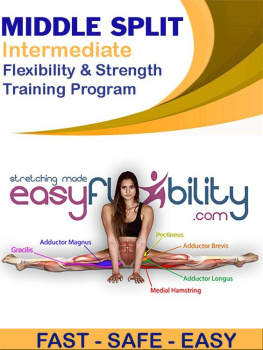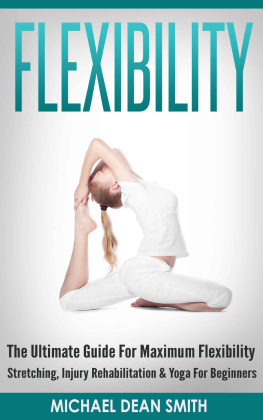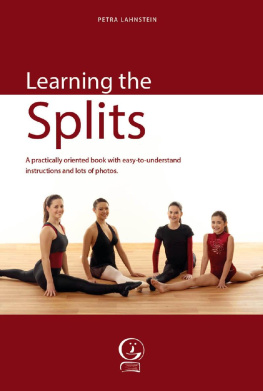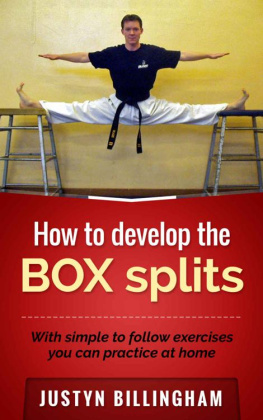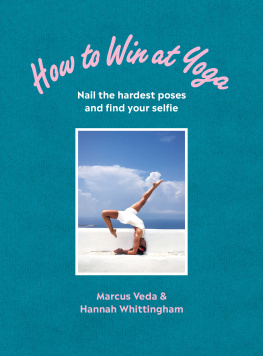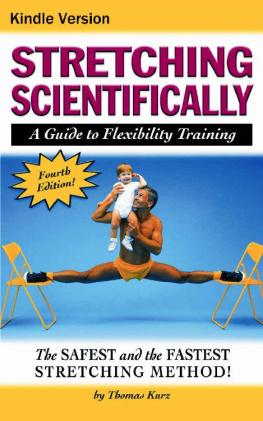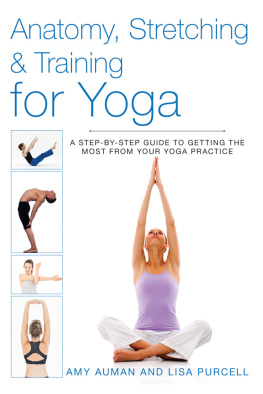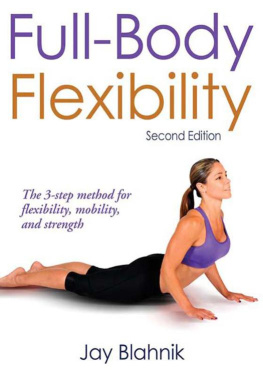You Can Do the Splits!Scientific Stretching
for
Fast Results!
Everything You Need to Know toAchieve Maximum Flexibility asQuickly, Safely and Efficiently as Possible!
Jon Deva
Copyright 2015 Deva PublicationsAll rights reserved.ISBN-13: 978-0692490228
DEDICATION
This book is dedicated to you, dear reader. You have sought out this valuableinformation and now all you have to do is learn it and apply it.Kudos to you! I wish you success in this and all your endeavors.
Jon Deva
Medical DisclaimerAlways consult your physician before beginning any exercise program. This generalinformation is not intended to diagnose any medical condition or to replace yourhealthcare professional.
Never disregard professional medical advice or delay in seeking it because ofsomething you have read in this or any other publication. Any content or information provided herein is for informational and educational purposes only and any usethereof is solely at your own risk. The author and publisher bears no responsibility thereof.
The information contained herein is not intended to be a substitute for professionalmedical advice, diagnosis or treatment in any manner. Always seek the advice of yourphysician or other qualified health provider with any questions you may haveregarding any medical condition. All information contained in this publication is forinformational and educational purposes only.
iv
CONTENTS 1How This Information Was DiscoveredPg. 1
2Understanding Methods of StretchingPg. 4
3Dynamic StretchingPg. 9
4PNF - Contract/Relax/Extend StretchingPg. 11
5Three Types of Stretching Used in this CoursePg. 15
6The Stretching Scientifically MethodPg. 17
7Introduction to Dynamic Stretching RoutinePg. 21
8How To: Front Leg SwingPg. 23
9How To: Side Leg SwingPg. 31
10How To: Back Leg SwingPg. 34
11Defining the SplitsPg. 38
12PNF Stretching for the Side SplitsPg. 4213PNF Stretching for the Front SplitsPg. 48
1
How this information was Collected/Researched/DiscoveredWhen I was a teenager, I started training in Kung Fu classes and doingyoga every day. In Kung Fu, everybody does warm-ups and stretchesat the beginning of class. In yoga, the entire class is devoted tostretching and assuming stretched postures. Yet in both of thoseclasses, I noticed that some people were naturally flexible and thatothers never seemed to make any gains in flexibility whatsoever,despite day after day, month after month of practicing. If you have everparticipated in a yoga or martial arts class for any period of time, you have probably noticed the same thing in yourself and others.
I did OK with my stretching. I was able to do a decent forward bend and I could kick high pretty easily, with my legs opening to about 160 degrees. But the full splits and those perfectly vertical kicks that the Chinese Kung Fu guys did in the movies seemed impossible to reach.Were they just naturally flexible? What were their training methods? Idecided to look into it.
In China, martial arts training goes back thousands of years andChinese people seem to have lots and lots of time on their hands. At a wushu school in china, you will typically find the students doing warmup stretches for a full TWO HOURS before they begin their actualkicking and punching routines that they spend the next six hours on.
So that was the way they did it. Just put in a full two hours of stretching every day and in a few weeks or months depending on your age you will reach your maximum potential. That was the Chinese way.Well, although I was dedicated to training, I didn't want to spend two hours of everyday stretching. I had school to go to, work to do, and Iwanted to have some time left to actually train in martial arts!
So I continued to search.
I discovered that many scientific studies on flexibility had been done in Russia by government sponsored scientists in the interest of improving their Olympic athletes. These studies were a gold mine of information.The Russian scientists tested everything, different kinds of stretching,different frequencies of stretching, different intensities of stretching,length of time in position, number of repetitions, etc. They tested everypossible variable to find out what the best methods of improvingflexibility actually were. There was a tremendous amount of information there, but I had to sort through all the studies and analyze the data to determine what variables had produced the best results.
What I discovered was that there were two kinds of stretching that had produced the best results in the shortest amount of time.
I learned the techniques, applied both of the methods to my practiceand in a short period of time, I was able to do the full splits, in everydirection, quite easily. So now here I am, 30 years later, still strong andflexible, and I have decided to share my secrets of strength andflexibility with you!
I am very happy and excited to share this method with you, and I'msure you will be very excited and pleased with the results as you learnhow easily and quickly you can achieve the flexibility you have alwaysdreamed of.
I'll See you in the next Chapter.
2
Understanding Methods of StretchingWelcome to the section on Understanding Methods of Stretching.
The first thing to understand is that while at first it may seem to be a simple thing, there are many, many methods of stretching. Depending on how you decide to divide them up, you can say there are six, eight,or even twelve or more methods of stretching.
We are not going to cover them all, and the pros and cons of each, in this book. I may produce an in-depth course in the future for personaltrainers and coaches, but this book is the quick and dirty, how to get in the splits as fast as possible course, so we only need to talk about three kinds of stretching.
The three kinds of stretching we will learn about now are:
Static,
Dynamic, and
PNF stretching, which is also known as
Contract/Relax/Extend stretching.What follows is an introduction and overview of each of these threetypes.
1: Static Stretching
2: Dynamic Stretching
3: PNF- Contract/Relax/Extend StretchingLet's begin:
Static StretchingWere going to start by talking about static stretching because it is themost well-known and common form of stretching. We will learn exactlywhat it is, how most people do it, whats wrong with how most peopledo it, common mistakes, what it is actually good for, and how and when to do it correctly. Static stretching is actually not a focus of this course,but it is necessary to understand it completely, how to do it right, andhow it is different from the other types of stretching that we will be utilizing to get into the splits fast.
What it is:Common Static Stretching can more specifically be called Static Passive Relaxed Stretching. This is because the way that staticstretching is usually done is by moving a muscle to the far limit of itsrange of motion, then relaxing the muscle and just holding the positionfor a period of time.
For example, to stretch the
back of the leg, you might lift
your leg onto a bar or
horizontal surface, stretching
the leg out straight and then
just holding the position, with
the muscles on the back of
the leg stretched, but relaxed
as possible. Since the weight
of the leg is supported, both
the muscles on the front and
back of the leg are relaxed.

Thats what makes it
Passive Relaxed. And of course, you are not moving, so thats whatmakes it Static.
Or, you might be seated on the ground with your legs spread as farapart as possible. You then bend forward between the legs and overthe legs and hold the position. In this stretch you are attempting tostretch the muscles on the back of the leg and the inside of the leg.Since you are supported by the floor, all of these muscles remainrelaxed, and you just hold the position. You are not moving, so the pose is


